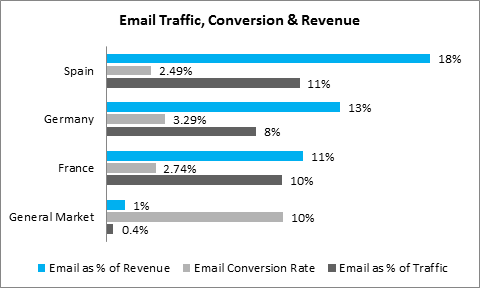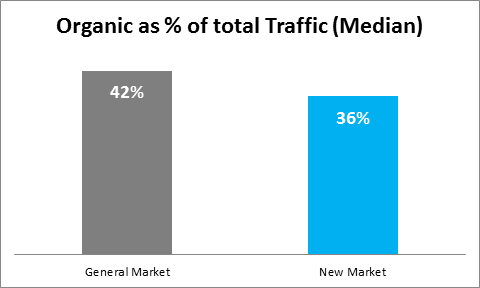One of the many business revolutions the Internet helped bring about is the elimination of physical borders for so many industries: communications, commerce, content, and more. Indeed, if a company wants to sell to a new global market these days, doing so via the web is the fastest-and almost always most economical-way to do it.
Unfortunately, companies tend to abandon this global online strategy when it doesn’t generate immediate, meaningful results. The reason why is a mystery for these organizations—after all, they performed their due diligence, they researched the global business opportunities and challenges, and even launched a localized website in the market’s preferred language. Hvad gik der galt?
These stories often have a common thread: they lack a particular ingredient for success.
Penetrating a new online market is a project that's often assigned to a company's IT, communications or e-commerce teams. These teams will diligently deliver on expectations-checking off the proverbial to-do "box"-and will then shift focus to another business strategy. After all, that to-do list is a mile long.
The missing ingredient? Marketing. Localized sites that have no accompanying marketing strategy are often doomed to fail. This "Marketing 101" axiom is one that many companies overlook for their overseas markets: if customers don't know a product or service exists, they won't seek it out. As a result, global sites generate very little traffic and even less revenue. They provide no value to the business.
Thankfully, most marketing best practices for international online markets have a lot in common with a company's primary-market. Here are three strategies your company can embrace that, when executed properly, deliver great results in overseas online markets:
Email Marketing
Your business probably already has a successful email marketing strategy for its primary market, and is using it to track conversions, promote new products, or simply maintain brand recognition and affinity. You'll want to leverage an email strategy for your new markets, too-though translating your primary-market emails won't be enough.
Why? Your brand has lots of credibility and history in your primary market … but as a newcomer to a new global market, you must craft different messaging to build brand reputation. It's a different game, to win consumers' trust-and their business.
We've seen this time and again with our clients. In the case of one client, it was impressive that their email conversion rate was 10% for their general-market website (in English). However, traffic was less than 1% for this site-meaning only English-speaking users that were really engaged with the brand were driving email revenue to the site.
On the other hand, email traffic for this client's French, German and Spanish sites fluctuated between 8% to 11%, and conversion rates ranged from 2.49% to 3.29%. Translation: Their global email strategy successfully drove users to the site, but the comparatively lower conversion rates suggested the company needed to gain user trust in the website or company.
For markets such as Russia, Latin America and Eastern Europe, email strategies are highly effective. This is thanks to high open rates. If you want to capitalize on the curiosity of these international customers, be sure to make your messages clear, engaging, and local.


Search Engine Optimization (SEO)
International SEO requires a similar, yet different, skill and toolset compared to domestic efforts. Firstly, Google is not the top search engine in many important markets, so a fluency in regional search engines is a must. That said, Google is becoming more and more accurate in local search in global markets. Further, language indexes are getting bigger and better.
Websites around the world are built with the latest technologies and techniques. Even still, very few commercial SEO tools are really useful for international SEO. Use them judiciously. As with your domestic English-speaking market, the quality of content is the base for a good international SEO strategy.
Maintaining a content-rich website with a great user experience goes miles towards signaling to new global customers (and their preferred regional search engines) that your localized website is an authority and can be trusted. Keyword strategy is also quite different in international markets. We recently examined the performance of organic keywords in Google and Bing, and compared them with keyword reports from international search engines such as Yandex (Russia), Baidu (China) and Naver (South Korea).
You undoubtedly know that your company benefits from using branded keywords in mature markets. In fact, we found these branded terms can deliver more than 70% of a company's "organic" traffic via search. Meanwhile, the performance of keywords in emerging markets hinges far less on branding, and far more on words based on products, services or long-tail keywords. The takeaway: Don't bang the drum for your brand in overseas markets at first. No one knows who you are. Tout products and services first.


Conversion Rate Optimization (CRO)
Conversion Rate Optimization has proven to be a significant source of revenue for sites. Localization and personalization are key optimizations that many companies are exploring.
Indeed, many companies are testing at least a dozen personalization variations on any given day. Some of these tests are so granular that the impact to overall conversion rates is measured in the tenths of a percent—but these incremental boosts can generate large revenues for a site.
This kind of personalization is possible for global markets, too. Here, it’s especially important to know the local consumers and culture, and adapt the localized site to transcend translation and feel like an authentically local website.
For instance: Suppose your company is a recognized brand in France, and you operate a localized Spanish site for the Latin American market. It's late Spring in France, and so you create a campaign to promote bathing suits. Summer is coming, after all.
This promotion won't just fail in Argentina-it'll make your brand a laughing stock there. Argentinian users won't appreciate that kind of campaign, as that market is approaching winter during that time of the year!
Senest opdateret d. 09. oktober 2015